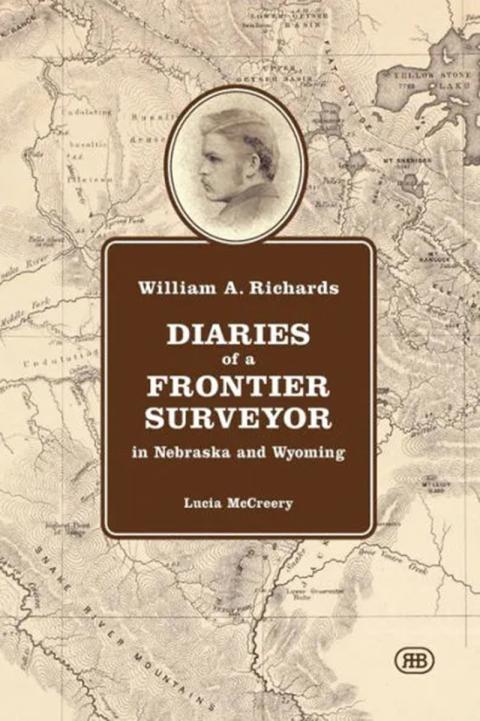A Frontier Surveyor
William A. Richards: Diaries of a Frontier Surveyor in Nebraska and Wyoming, by Lucia McCreery. Red Bank Press, Brooklyn, New York, 2023, 270 pages. 26.95 paperback.
By Rebecca Hein
All these years, I fear I’ve been a member of the Flat Earth Society—and never realized it until I read this book. In the Introduction, I read, “Surveys for latitude, such as the 1873 Wyoming boundary survey, required constant corrections and astronomical checks to the survey along an east-west curve.”

Huh? I thought, and later asked my math-and-science oriented husband, “Why would the frontier surveyor William Richards have to survey the southern boundary of Wyoming on a curve, when the boundary is straight?”
Ellis replied, “To correct for the curvature of the Earth.”
I excuse myself on the grounds of distraction. I already knew the sagas of Richards’s surveys of Wyoming Territory’s southern and western boundaries. Although William Richards’s brother Alonzo actually held the contracts for both surveys, Alonzo only took part in the southern boundary survey. William did much of that work, and most of the western boundary work. (Two decades later, William would be elected governor of Wyoming.)
The Richards brothers and their crews did the surveys in 1873 and 1874, well before the age of fossil fuels, grocery stores in the unsettled West and 20th century surveying tools. This meant they and their helpers often hacked through dense stands of timber, essentially building their roads and clearing space for the surveys by manual labor. Though they carried staples such as flour and sugar, they had to pause often to hunt, process their kills and cook the meat. Potable water was hit-or-miss, and perhaps because of this, temporary illnesses were common. In addition to their surveyor duties, they had to describe the landscape as they went along: “mountains, rivers, visible minerals, soil type, and vegetation, so the government would know more about what … [it] acquired in the Louisiana Purchase of 1803.”
This book is loaded with general information about surveying, starting with the introduction, in which the author describes surveying terms, tools and techniques. This long list includes, among other things, specialized items such as chains—“a kind of heavy-duty tape measure”—plus a transit: an instrument used to measure horizontal and vertical angles.
Correcting for the earth’s curvature required regular astronomical checks. Although Alonzo “was a U.S. astronomer himself, yet he engaged ‘the best observer in the U.S.’” The group set up five astronomical stations on the southern boundary with each station marked by a stone monument. Obtaining and hauling large enough and otherwise suitable stones was a huge job in itself.
Richards’s diaries vividly describe a time long past, when manual labor and horse and mule power were the only means of accomplishing many tasks. How did William find the time and energy to keep a diary? Modern readers would do well to value his legacy, especially as we use power tools, drive around, correspond by text or email and otherwise benefit from life in the 21st century.
Editor Lucia McCreery, great-granddaughter of William Richards, notes, “Surveyors in remote, difficult country often let precision slide on the assumption that nobody would notice or care, but the Richardses took pains to set precise boundary posts and monuments no matter how rough the terrain.” She clearly shares her ancestors’ high standards: The book’s content is clear, thorough and interesting, and has many useful illustrations. The appendix is also packed with surveying information. With 55 illustrations and photos, 22 in full color, and 30 maps and diagrams. For excerpts from the diaries, see https://www.williamarichards.com/diaries-excerpts.
Available at museums and libraries throughout the state, at williamarichards.com and various online outlets.
Rebecca Hein is an assistant editor at WyoHistory.org.
Read “The Roughest Mountains & Deepest Cañons:” William Richards and the Boundary Survey of 1874
